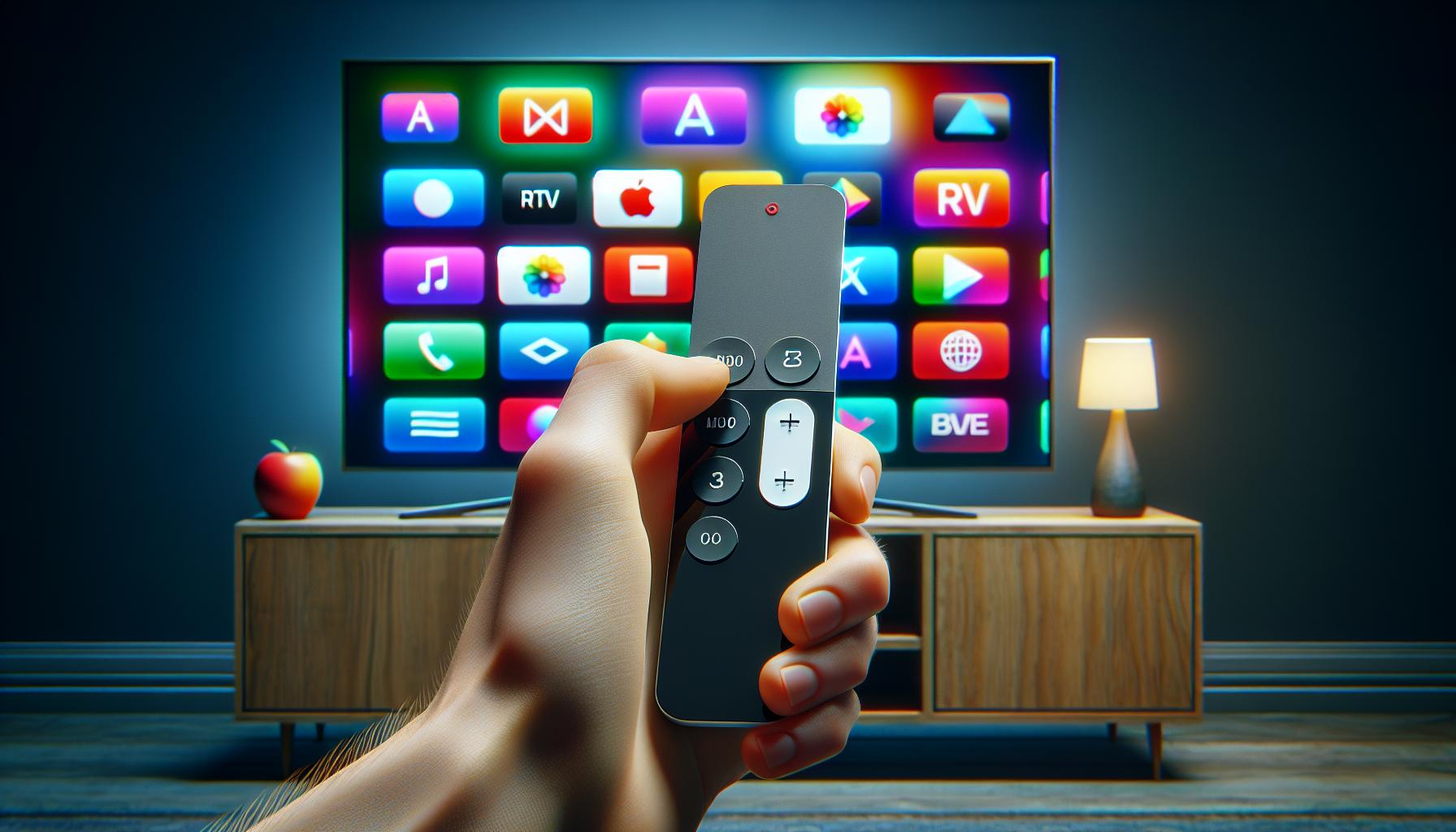Experiencing issues with your Apple TV remote? Don't fret, you're not alone. It's a common issue that can often be solved by a simple reset. This guide will walk you through the process step by step, ensuring you're back to your favorite shows in no time.
Resetting your Apple TV remote can solve a multitude of issues, from unresponsiveness to connectivity problems. It's a straightforward process that doesn't require any technical expertise. So whether you're a tech whiz or a novice, you'll find this guide easy to follow.
Stay tuned as we dive into the nitty-gritty of resetting your Apple TV remote. You'll be surprised at how simple it is! So, let's get started and get your Apple TV remote back up and running.
Why Resetting Your Apple TV Remote Is Important
After educating you on common Apple TV remote issues and explaining the basics of the reset process, we should delve a bit deeper. Why is resetting your Apple TV remote important?
Well, it's not just about getting the remote back to a working state. It's also about maintaining the optimal performance of your Apple TV. A properly functioning remote ensures a seamless and enjoyable Apple TV experience. Resetting the remote helps clear any glitches or technical snags on the go, preventing them from escalating into bigger and more nuisance causing issues down the line.
Imagine you're right in the middle of a gripping movie or an intense game when your remote starts acting up. The scene is ruined and your game potentially lost. This situation is what a quick reset helps you avoid, ensuring that you stay on track with your viewing or gaming experience.
In addition, remote issues can sometimes mask more significant issues with the Apple TV itself. Resetting the remote can aid in diagnosing these larger problems. Think of it like a first line of defense, allowing you to rule out remote malfunctions before delving deeper into potentially larger hardware issues. So, it's not just about handling remote challenges but playing a broader role in maintaining your overall Apple TV's health.
The table below succinctly presents the importance of resetting your Apple TV remote:
| Benefits | Description |
|---|---|
| Enhanced user experience | Prevention of interruptions in viewing or gaming sessions. |
| Diagnosing Larger Issues | Helps rule out remote malfunction and identifies significant hardware issues. |
| Maintains Apple TV's overall performance | Keeps your device running at its peak. |
Now that the importance of resetting your Apple TV remote is clear, let's continue to the detailed procedure that follows.
Step 1: Verify the Battery Level

Let's get started. The first thing you're going to want to do is to check the battery level of your Apple TV remote. While it may seem a tad basic, it's an essential step that many folks tend to skip. Remember, even electronics have issues sometimes.
Your Apple TV remote might actually not need resetting. The culprit could be something as minor as a low battery level. Before jumping into the reset process, it's recommended to verify the current state of your remote's battery.
To do this, you need to navigate to the Apple TV settings. From the main menu, select Settings > Remotes and Devices > Remote. In this section, you will find the battery level displayed. If the battery level appears to be low, it's time for a fresh change of batteries.
Swapping out the batteries might just do the trick. Have extra batteries on hand. You'd be surprised at how often battery issues are confused for faulty remotes.
Here's a simple table showcasing the steps to check your battery level:
| Steps | Action |
|---|---|
| 1 | Navigate to Apple TV settings |
| 2 | Select 'Remotes and Devices' |
| 3 | Click on 'Remote' |
| 4 | Check the battery level |
After ensuring your remote's battery level is not the underlying problem, you can proceed to resetting your Apple TV remote with peace of mind. While this step may seem basic, it's a crucial part of the process. Knowing the health of your remote's battery can save a lot of time and avert unnecessary resets.
As you've understood how important the battery level check is, let's dive into the actual reset process in the next section.
Step 2: Check for Physical Damage
Now that you've confirmed the battery level isn't the issue, it's time to move onto the next step. Physical damage is often overlooked, but it's a critical factor that could be causing your Apple TV remote problems. An unfortunately timed drop or a bump can harm the internal components, leading to a faulty device.
Start by inspecting your remote's button functionality. Press each button, including the directional pad and the volume controls, to ensure they're responding properly. If you encounter any buttons that seem stuck or require extra force, this could be a sign of physical damage hindering your device's functionality.
Next, look for any visible signs of external damage. Cracks, dents, or noticeable wear and tear can indicate damage that might be affecting your remote's operation. Pay particular attention to the top glass touch surface as well as the bottom lightning port. Damage here could affect core functionalities of your Apple remote.
Don't forget to inspect the Lightning connector on the remote as well. If you spot any visible damage or debris, it may interfere with charging. This can mimic the symptoms of a faulty remote.
Keep in mind, if you identify any signs of physical damage, it might be more cost-effective and practical to replace your remote. However, if everything seems intact, this suggests that your remote's issue lies elsewhere. You're doing great, so stick with it! Let's move onto the next step of our troubleshooting process.
Keep the following points in mind while inspecting your remote:
- Button functionality
- External damage
- Lightning connector condition
Remember, the goal is to identify any potential issues that might be causing your remote to malfunction. Don't rush these steps! Patience could save you from having to invest in a new device.
Step 3: Unpairing the Remote
If you've inspected the Apple TV remote and can confirm there's no physical damage, you'll move to the next critical step. This is unpairing the remote from your Apple TV, should you find your remote's functionality quite unpredictable or altogether non-responsive.
Now why is unpairing important? Unpairing effectively resets the remote by eliminating any prior connections, potentially resolving any latent bugs or glitches preventing the smooth operation of the remote.
So, how do you unpair your Apple TV remote? Good news is, it’s pretty straightforward.
For Siri Remote or Apple TV Remote, you should:
- Press and hold the ‘Menu’ and ‘Volume Up’ buttons for about 5 seconds.
- Check if your remote is unpaired by trying to adjust the volume.
As for the Apple Remote (aluminum or white):
- Press and hold the ‘Menu’ and ‘Left’ buttons for about 6 seconds.
- Try using the remote with your Apple TV.
If you are unable to unpair your remote using these steps, or it seems already unpaired, but you still face issues, there's no need to fear. You can reset your Apple TV itself to further help resolve the remote malfunction. Let us move on to the next step in this troubleshooting chronicle. Trust us, you’re one step closer to regaining full control over your Apple TV experience.
Step 4: Resetting the Remote

When unpairing doesn't cut it, it's time to pull out the big guns and reset the remote. Resetting the Apple TV remote is sometimes the most effective solution to persistent issues. It's similar to rebooting a computer or phone, which often fixes a multitude of problems.
Now the specifics depend on what type of Apple TV remote you have. Is it the Siri remote or the silver Apple TV Remote? The method varies for each but don’t worry, we've got you covered for both.
For the Siri Remote or Apple TV Remote*
If you're the proud owner of a Siri Remote or an Apple Remote, then follow these quick and simple steps:
- On your remote, press and hold the Menu and Volume Up buttons.
- After about 5 seconds, the status light on your Apple TV should start blinking.
And ta-da, your remote is now reset!
For the Silver Apple TV Remote
If you have the shiny Silver Apple TV remote, then adhere to these steps to reset:
- On your remote, press and hold the Menu and Left buttons.
- Similar to the Siri Remote, the status light on your Apple TV will start blinking after about 5 seconds.
Again, it's as simple as that. Following these steps allows a complete reset of the remote, offering a clean slate for you to work with.
But what if these solutions haven't rectified your remote issues? Don't throw in the towel quite yet! These are just a few pointers to get your Apple TV remote revving again. There are more techniques up our sleeves that might just do the trick. So let’s dive in and explore those next.
Conclusion
So there you have it. You're now well-equipped to reset your Apple TV remote, whether it's the Siri version or the silver one. Remember, just like rebooting a computer or phone, resetting your remote often solves those nagging issues. If the problem persists after a reset, don't worry. There are more troubleshooting techniques to explore. You've got this. With your newfound knowledge, you're ready to tackle any Apple TV remote issues that come your way.
Frequently Asked Questions
How do you reset an Apple TV remote?
To reset your Apple TV remote, the procedure varies based on the type of remote you have. The article outlined the steps for both the Siri remote and the Silver Apple TV remote.
What should I do if my Apple TV remote is not working even after a reset?
If your Apple TV remote still doesn't work after a reset, you can troubleshoot further by referring to the techniques illustrated in the article.
Is resetting my Apple TV remote is similar to rebooting a computer or phone?
Yes, resetting your Apple TV remote is akin to rebooting a computer or phone. It can help resolve persistent technical issues with the device.
What other methods does the article suggest when resetting doesn't work?
The article highlights several techniques to resolve issues persisting after a reset. Please review the article thoroughly for an in-depth understanding.




